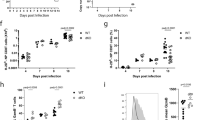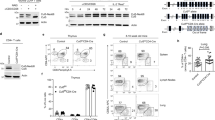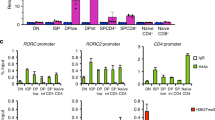Abstract
The lineage commitment of CD4+ T cells is coordinately regulated by signals through the T cell receptor and cytokine receptors, yet how these signals are integrated remains elusive. Here we find that mice lacking Dock2, a Rac activator in lymphocytes, developed allergic disease through a mechanism dependent on CD4+ T cells and the interleukin 4 receptor (IL-4R). Dock2-deficient CD4+ T cells showed impaired antigen-driven downregulation of IL-4Rα surface expression, resulting in sustained IL-4R signaling and excessive T helper type 2 responses. Dock2 was required for T cell receptor–mediated phosphorylation of the microtubule-destabilizing protein stathmin and for lysosomal trafficking and the degradation of IL-4Rα. Thus, Dock2 links T cell receptor signals to downregulation of IL-4Rα to control the lineage commitment of CD4+ T cells.
This is a preview of subscription content, access via your institution
Access options
Subscribe to this journal
Receive 12 print issues and online access
$209.00 per year
only $17.42 per issue
Buy this article
- Purchase on Springer Link
- Instant access to full article PDF
Prices may be subject to local taxes which are calculated during checkout






Similar content being viewed by others
References
Mosmann, T.R. & Coffman, R.L. TH1 and TH2 cells: different patterns of lymphokine secretion lead to different functional properties. Annu. Rev. Immunol. 7, 145–173 (1989).
Abbas, A.K., Murphy, K.M. & Sher, A. Functional diversity of helper T lymphocytes. Nature 383, 787–793 (1996).
Hosken, N.A., Shibuya, K., Heath, A.W., Murphy, K.M. & O'Garra, A. The effect of antigen dose on CD4+ T helper cell phenotype development in a T cell receptor-αβ-transgenic model. J. Exp. Med. 182, 1579–1584 (1995).
Constant, S., Pfeiffer, C., Woodard, A., Pasqualini, T. & Bottomly, K. Extent of T cell receptor ligation can determine the functional differentiation of naive CD4+ T cells. J. Exp. Med. 182, 1591–1596 (1995).
Iezzi, G., Scotet, E., Scheidegger, D. & Lanzavecchia, A. The interplay between the duration of TCR and cytokine signaling determines T cell polarization. Eur. J. Immunol. 29, 4092–4101 (1999).
Glimcher, L.H. & Murphy, K.M. Lineage commitment in the immune system: the T helper lymphocyte grows up. Genes Dev. 14, 1693–1711 (2000).
Lanzavecchia, A. & Sallusto, F. Antigen decoding by T lymphocytes: from synapses to fate determination. Nat. Immunol. 2, 487–492 (2001).
Murphy, K.M. & Reiner, S.L. The lineage decisions of helper T cells. Nat. Rev. Immunol. 2, 933–944 (2002).
Nelms, K., Keegan, A.D., Zamorano, J., Ryan, J.J. & Paul, W.E. The IL-4 receptor: signaling mechanisms and biologic functions. Annu. Rev. Immunol. 17, 701–738 (1999).
Schluns, K.S. & Lefrançois, L. Cytokine control of memory T-cell development and survival. Nat. Rev. Immunol. 3, 269–279 (2003).
Kaplan, M.H., Schindler, U., Smiley, S.T. & Grusby, M.J. Stat6 is required for mediating responses to IL-4 and for the development of Th2 cells. Immunity 4, 313–319 (1996).
Avni, O. et al. TH cell differentiation is accompanied by dynamic changes in histone acetylation of cytokine genes. Nat. Immunol. 3, 643–651 (2002).
Ouyang, W. et al. Inhibition of Th1 development mediated by GATA-3 through an IL-4-independent mechanism. Immunity 9, 745–755 (1998).
Zheng, W. & Flavell, R.A. The transcription factor GATA-3 is necessary and sufficient for Th2 cytokine gene expression in CD4 T cells. Cell 89, 587–596 (1997).
Ho, I.C., Hodge, M.R., Rooney, J.W. & Glimcher, L.H. The proto-oncogene c-maf is responsible for tissue-specific expression of interleukin-4. Cell 85, 973–983 (1996).
Usui, T., Nishikomori, R., Kitani, A. & Strober, W. GATA-3 suppresses Th1 development by downregulation of Stat4 and not through effects on IL-12Rβ2 chain or T-bet. Immunity 18, 415–428 (2003).
Schmidt, A. & Hall, A. Guanine nucleotide exchange factors for Rho GTPases: turning on the switch. Genes Dev. 16, 1587–1609 (2002).
Curmi, P.A. et al. Stathmin and its phosphoprotein family: general properties, biochemical and functional interaction with tubulin. Cell Struct. Funct. 24, 345–357 (1999).
Daub, H., Gevaert, K., Vandekerckhove, J., Sobel, A. & Hall, A. Rac/Cdc42 and p65PAK regulate the microtubule-destabilizing protein stathmin through phosphorylation at serine 16. J. Biol. Chem. 276, 1677–1680 (2001).
Wittmann, T., Bokoch, G.M. & Waterman-Storer, C.M. Regulation of leading edge microtubule and actin dynamics downstream of Rac1. J. Cell Biol. 161, 845–851 (2003).
Wittmann, T., Bokoch, G.M. & Waterman-Storer, C.M. Regulation of microtubule destabilizing activity of Op18/Stathmin downstream of Rac1. J. Biol. Chem. 279, 6196–6203 (2004).
Li, B. et al. Role of the guanosine triphosphatase Rac2 in T helper 1 cell differentiation. Science 288, 2219–2222 (2000).
Croker, B.A. et al. Rac2-deficient mice display perturbed T-cell distribution and chemotaxis, but only minor abnormalities in TH1 responses. Immunol. Cell Biol. 80, 231–240 (2002).
Reiner, S.L. & Locksley, R.M. The regulation of immunity to Leishmania major. Annu. Rev. Immunol. 13, 151–177 (1995).
Fukui, Y. et al. Haematopoietic cell-specific CDM family protein DOCK2 is essential for lymphocyte migration. Nature 412, 826–831 (2001).
Brugnera, E. et al. Unconventional Rac-GEF activity is mediated through the Dock 180-ELMO complex. Nat. Cell Biol. 4, 574–582 (2002).
Côté, J.F. & Vuori, K. Identification of an evolutionarily conserved superfamily of DOCK180-related proteins with guanine nucleotide exchange activity. J. Cell Sci. 115, 4901–4913 (2002).
Sanui, T. et al. DOCK2 is essential for antigen-induced translocation of TCR and lipid rafts, but not PKC-θ and LFA-1, in T cells. Immunity 19, 119–129 (2003).
Mowen, K.A. & Glimcher, L.H. Signaling pathways in Th2 development. Immunol. Rev. 202, 203–222 (2004).
Vitetta, E.S. et al. Serological, biochemical and functional identity of B cell-stimulatory factor 1 and B cell differentiation factor for IgG1. J. Exp. Med. 162, 1726–1731 (1985).
Coffman, R.L. et al. B cell stimulatory factor-1 enhances the IgE response of lipopolysaccharide-activated B cells. J. Immunol. 136, 4538–4541 (1986).
Berg, L.J. et al. Antigen/MHC-specific T cells are preferentially exported from the thymus in the presence of their MHC ligard. Cell 58, 1035–1046 (1989).
Tanaka, S. et al. The interleukin-4 enhancer CNS-2 is regulated by Notch signals and controls initial expression in NKT cells and memory-type CD4 T cells. Immunity 24, 689–701 (2006).
Grogan, J.L. et al. Early transcription and silencing of cytokine genes underlie polarization of T helper cell subsets. Immunity 14, 205–215 (2001).
Nagahara, H. et al. Transduction of full-length TAT fusion proteins into mammalian cells: TAT-p27kipl induces cell migration. Nat. Med. 4, 1449–1452 (1998).
McGraw, T.E., Dunn, K.W. & Maxfield, F.R. Isolation of a temperature-sensitive variant Chinese hamster ovary cell line with a morphologically altered endocytic recycling compartment. J. Cell. Physiol. 155, 579–594 (1993).
Kelly, R.B. Microtubules, membrane traffic, and cell organization. Cell 61, 5–7 (1990).
Apodaca, G. Endocytic traffic in polarized epithelial cells: role of the actin and microtubule cytoskeleton. Traffic 2, 149–159 (2001).
Tepper, R.I. et al. IL-4 induces allergic-like inflammatory disease and alters T cell development in transgenic mice. Cell 62, 457–467 (1990).
Skrenta, H., Yang, Y., Pestka, S. & Fathman, C.G. Ligand-independent down-regulation of IFN-γ receptor 1 following TCR engagement. J. Immunol. 164, 3506–3511 (2000).
Regis, G., Conti, L., Boselli, D. & Novelli, F. IFNγR2 trafficking tunes IFNγ−STAT1 signaling in T lymphocytes. Trends Immunol. 27, 96–101 (2006).
Rahimpour, R. et al. Bacterial superantigens induce down-modulation of CC chemokine responsiveness in human monocytes via an alternative chemokine ligard-independent mechanism. J. Immunol. 162, 2299–2307 (1999).
Wang, J. et al. Role of tyrosine phosphorylation in ligand-independent sequestration of CXCR4 in human primary monocytes-macrophages. J. Biol. Chem. 276, 49236–49243 (2001).
Mozo, L., Rivas, D., Zamorano, J. & Gutierrez, C. Differential expression of IL-4 receptors in human T and B lymphocytes. J. Immunol. 150, 4261–4269 (1993).
Zhu, J. et al. Transient inhibition of interleukin 4 signaling by T cell receptor ligation. J. Exp. Med. 192, 1125–1134 (2000).
Reddy, C.C., Niyogi, S.K., Wells, A., Wiley, H.S. & Lauffenburger, D.A. Engineering epidermal growth factor for enhanced mitogenic potency. Nat. Biotechnol. 14, 1696–1699 (1996).
Fallon, E.M., Liparoto, S.F., Lee, K.J., Ciardelli, T.L. & Lauffenburger, D.A. Increased endosomal sorting of ligand to recycling enhances potency of an interleukin-2 analog. J. Biol. Chem. 275, 6790–6797 (2000).
Sonee, M., Barrón, E., Yarber, F.A. & Hamm-Alvarez, S.F. Taxol inhibits endosomal-lysosomal membrane trafficking at two distinct steps in CV-1 cells. Am. J. Physiol. 275, C1630–C1639 (1998).
Maldonado, R.A., Irvine, D.J., Schreiber, R. & Glimcher, L.H. A role for the immunological synapse in lineage commitment of CD4 lymphocytes. Nature 431, 527–532 (2004).
Acknowledgements
We thank A. Sobel (Institut National de la Santé et de la Recherche Médicale U706) for antibodies to phosphorylated stathmin and M. Kubo (Research Center for Allergy and Immunology, RIKEN Yokohama Institiute) for Il4ra−/− BALB/c mice. Supported by the Ministry of Education, Culture, Sports, Science and Technology of Japan (for the Genome Network Project and the Target Protein Project; Y.F.), the Precursory Research for Embryonic Science and Technology program of the Japan Science and Technology (Y.F.), Grants-in-Aid for Scientific Research from the Japan Society for the Promotion of Science and the Ministry of Education, Culture, Sports, Science and Technology of Japan (Y.T. and Y.F.), the Toray Science Foundation (Y.F.) and the ONO Medical Research Foundation (Y.F.).
Author information
Authors and Affiliations
Contributions
Y.T. did experiments, analyzed data and contributed to manuscript preparation; S.H. did experiments and analyzed data; K.G., Y.M., Y.K., A.N., R.T., M.K. and A.I. did experiments; S.M., K.H. and T.S. interpreted data; and Y.F. designed experiments, analyzed and interpreted data and wrote the manuscript.
Corresponding author
Supplementary information
Supplementary Text and Figures
Supplementary Figures 1–4, Tables 1–2 and Methods (PDF 2846 kb)
Rights and permissions
About this article
Cite this article
Tanaka, Y., Hamano, S., Gotoh, K. et al. T helper type 2 differentiation and intracellular trafficking of the interleukin 4 receptor-α subunit controlled by the Rac activator Dock2. Nat Immunol 8, 1067–1075 (2007). https://doi.org/10.1038/ni1506
Received:
Accepted:
Published:
Issue Date:
DOI: https://doi.org/10.1038/ni1506
This article is cited by
-
Multiple Immune Defects in Two Patients with Novel DOCK2 Mutations Result in Recurrent Multiple Infection Including Live Attenuated Virus Vaccine
Journal of Clinical Immunology (2023)
-
Biologics for Allergic Dermatologic Diseases
Current Allergy and Asthma Reports (2020)
-
Dupilumab to Treat Type 2 Inflammatory Diseases in Children and Adolescents
Pediatric Drugs (2020)
-
The AP-1 transcription factor JunB is required for Th17 cell differentiation
Scientific Reports (2017)
-
Neuronal IFN-beta–induced PI3K/Akt-FoxA1 signalling is essential for generation of FoxA1+Treg cells
Nature Communications (2017)



